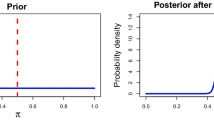Abstract
Hierarchical models are commonly used for modelling uncertainty. They arise whenever there is a `correct' or `ideal' uncertainty model but the modeller is uncertain about what it is. Hierarchical models which involve probability distributions are widely used in Bayesian inference. Alternative models which involve possibility distributions have been proposed by several authors, but these models do not have a clear operational meaning. This paper describes a new hierarchical model which is mathematically equivalent to some of the earlier, possibilistic models and also has a simple behavioural interpretation, in terms of betting rates concerning whether or not a decision maker will agree to buy or sell a risky investment for a specified price. We give a representation theorem which shows that any consistent model of this kind can be interpreted as a model for uncertainty about the behaviour of a Bayesian decision maker. We describe how the model can be used to generate buying and selling prices and to make decisions.
Similar content being viewed by others
REFERENCES
Aumann, R. J. (1962), Utility theory without the completeness axiom. Econometrica 30, 445–462.
Berger, J. O. (1985), Statistical Decision Theory and Bayesian Analysis, New York: Springer-Verlag.
Berger, J. O. (1994), An overview of robust Bayesian analysis, Test 3, 5–124, (With discussion).
De Cooman, G. (1997a), Possibility theory I: the measure-and integral-theoretic groundwork, International Journal of General Systems 25, 291–323.
De Cooman, G. (1997b), Possibility theory II: conditional possibility, International Journal of General Systems 25, 325–351.
De Cooman, G. (1997c), Possibility theory III: possibilistic independence. International Journal of General Systems 25, 353–371.
De Cooman, G. (1998), Possibilistic previsions, in: Proceedings of IPMU' 98, Vol. I. Paris: Éditions EDK, pp. 2–9.
De Cooman, G. (1999), Lower desirability functions: a convenient imprecise hierarchical uncertainty model, in: G. de Cooman, F. G. Cozman, S. Moral and P. Walley (eds.), ISIPTA' 99 - Proceedings of the First International Symposium on Imprecise Probabilities and Their Applications. Ghent: Imprecise Probabilities Project, pp. 111–120.
De Cooman, G. (2000), Precision-imprecision equivalence in a broad class of imprecise hierarchical uncertainty models, Journal of Statistical Planning and Inference, (accepted for publication).
De Cooman, G.: (2001), A behavioural model for vague probability assessments, (in preparation).
De Cooman, G. and D. Aeyels (1999), Supremum preserving upper probabilities, Information Sciences 118, 173–212.
De Finetti, B. (1974), Theory of Probability, Vol. 1. Chichester: John Wiley & Sons. English Translation of Teoria delle Probabilità.
Dickey, J. M. (1980), Beliefs about beliefs, a theory for stochastic assessments of subjective probabilities, in: J. M. Bernardo, M. H. DeGroot, D. V. Lindley and A. F. M. Smith (eds.), Bayesian Statistics, Vol. 1. Valencia: Valencia University Press, pp. 471–487 and 504–519, (with discussion)
Dubois, D. and H. Prade (1988), Possibility Theory. New York: Plenum Press.
Freeling, A. N. S. (1980), Fuzzy sets and decision analysis, IEEE Transactions on Systems, Man and Cybernetics 10, 341–354.
Gärdenfors, P. and N.-E. Sahlin (1982), Unreliable probabilities, risk taking, and decision making, Synthese 53, 361–386.
Gärdenfors, P. and N.-E. Sahlin (1983), Decision making with unreliable probabilities, British Journal of Mathematical & Statistical Psychology 36, 240–251.
Gilboa, I. and D. Schmeidler (1989), Maxmin expected utility with a non-unique prior. Journal of Mathematical Economics 18, 141–153.
Good, I. J. (1962), Subjective probability as the measure of a non-measurable set, in: E. Nagel, P. Suppes and A. Tarski (eds.): Logic, Methodology and Philosophy of Science. Stanford: Stanford University Press, pp. 319–329.
Good, I. J. (1980, Some history of the hierarchical Bayesian methodology. in: J. M. Bernardo, M. H. DeGroot, D. V. Lindley and A. F. M. Smith (eds.), Bayesian Statistics, Vol. 1. Valencia: Valencia University Press, pp. 489–519.
Mellor, D. H. (1980), Consciousness and degrees of belief. in: D. H. Mellor (ed.), Prospects for Pragmatism. Cambridge: Cambridge University Press.
Moral, S. (1992), Calculating uncertainty intervals from conditional convex sets of probabilities, in: D. Dubois, M. P. Wellman, B. D'Ambrosio and P. Smets (eds.), Proceedings of the Eighth Conference on Uncertainty in Artificial Intelligence. San Mateo CA: Morgan Kaufmann, pp. 199–206.
Nau, R. F. (1992), Indeterminate probabilities on finite sets, The Annals of Statistics 20, 1737–1767.
Pan, Y. (1997), Fuzzy Probability Calculus, Ph.D. thesis, Binghamton University (SUNY).
Pan, Y. and B. Yuan (1997), Bayesian inference of fuzzy probabilities, International Journal of General Systems 26, 73–90.
Skyrms, B. (1980), Higher order degrees of belief, in: D. H. Mellor (ed.), Prospects for Pragmatism. Cambridge: Cambridge University Press.
Smith, C. A. B. (1961), Consistency in statistical inference and decision, Journal of the Royal Statistical Society, Series A 23, 1–37.
von Winterfeldt, D. and W. Edwards (1986), Decision Analysis and Behavioral Research. Cambridge: Cambridge University Press.
Walley, P. (1991), Statistical Reasoning with Imprecise Probabilities. London: Chapman and Hall.
Walley, P. (1997), Statistical inferences based on a second-order possibility distribution, International Journal of General Systems 26, 337–383.
Walley, P. and G. De Cooman (2001), A behavioural model for linguistic uncertainty, Information Sciences 134, 1–37.
Wallsten, T. S., D. V. Budescu, A. Rapoport, R. Zwick and B. Forsyth (1986), Measuring the vague meanings of probability terms, Journal of Experimental Psychology: General 115, 348–365.
Watson, S. R., J. J. Weiss and M. L. Donnell, (1979), Fuzzy decision analysis. IEEE Transactions on Systems, Man, and Cybernetics 9, 1–9.
Zadeh, L. A. (1976), The concept of a linguistic variable and its application to approximate reasoning III. Information Sciences 9, 43–80.
Zadeh, L. A. (1978), Fuzzy sets as a basis for a theory of possibility, Fuzzy Sets and Systems 1, 3–28.
Zadeh, L. A. (1984), Fuzzy probabilities, Information Processing and Management 20, 363–372.
Zadeh, L. A. (1986), Is probability theory sufficient for dealing with uncertainty in AI: a negative view, in: L. N. Kanal and J. F. Lemmer (eds.), Uncertainty in Artificial Intelligence. Amsterdam, pp. 103–116.
Zellner, A. (1971), An Introduction to Bayesian Inference in Econometrics. New York: Wiley.
Author information
Authors and Affiliations
Rights and permissions
About this article
Cite this article
de Cooman, G., Walley, P. A possibilistic hierarchical model for behaviour under uncertainty. Theory and Decision 52, 327–374 (2002). https://doi.org/10.1023/A:1020296514974
Issue Date:
DOI: https://doi.org/10.1023/A:1020296514974




